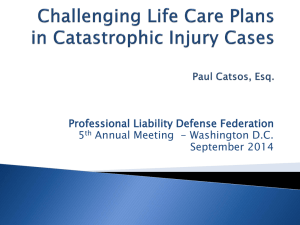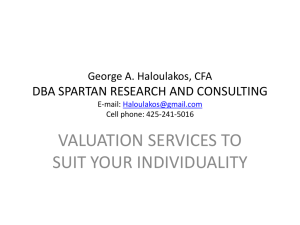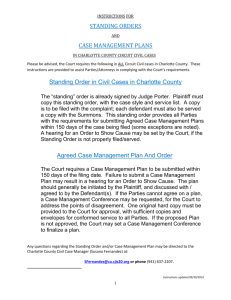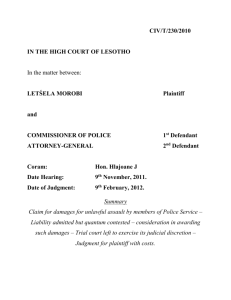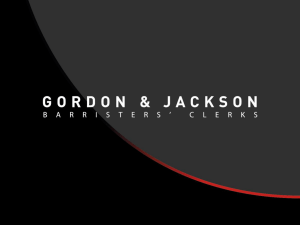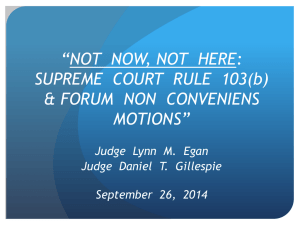Wermann v. Excel Dentistry PC
advertisement
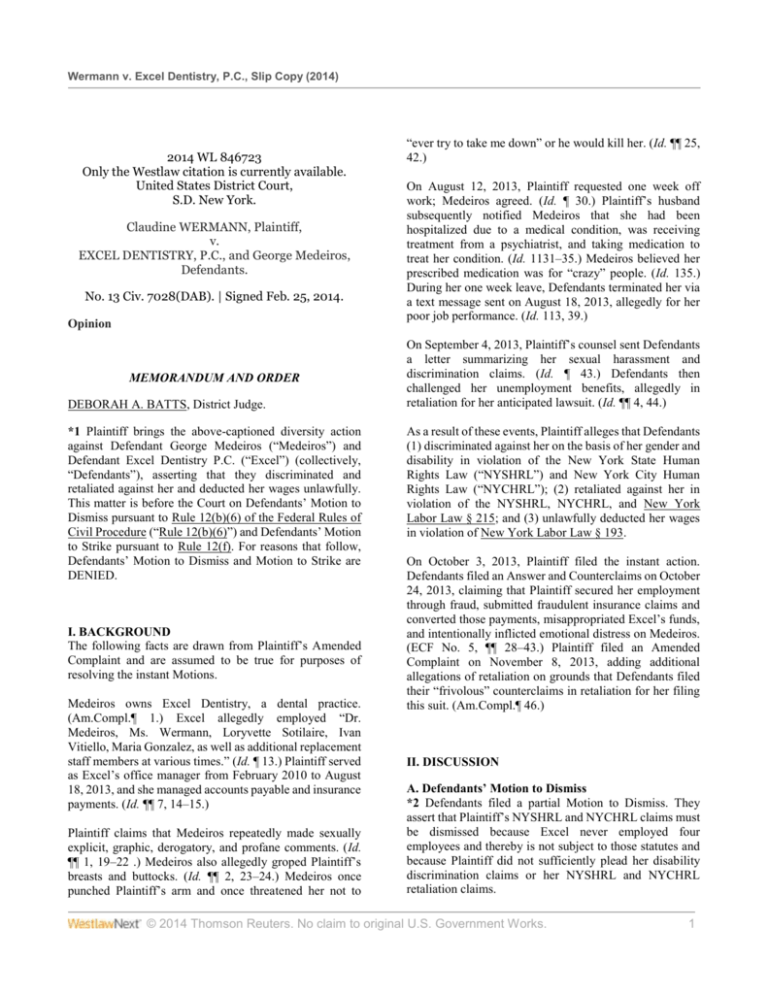
Wermann v. Excel Dentistry, P.C., Slip Copy (2014) 2014 WL 846723 Only the Westlaw citation is currently available. United States District Court, S.D. New York. Claudine WERMANN, Plaintiff, v. EXCEL DENTISTRY, P.C., and George Medeiros, Defendants. No. 13 Civ. 7028(DAB). | Signed Feb. 25, 2014. Opinion MEMORANDUM AND ORDER DEBORAH A. BATTS, District Judge. *1 Plaintiff brings the above-captioned diversity action against Defendant George Medeiros (“Medeiros”) and Defendant Excel Dentistry P.C. (“Excel”) (collectively, “Defendants”), asserting that they discriminated and retaliated against her and deducted her wages unlawfully. This matter is before the Court on Defendants’ Motion to Dismiss pursuant to Rule 12(b)(6) of the Federal Rules of Civil Procedure (“Rule 12(b)(6)”) and Defendants’ Motion to Strike pursuant to Rule 12(f). For reasons that follow, Defendants’ Motion to Dismiss and Motion to Strike are DENIED. I. BACKGROUND The following facts are drawn from Plaintiff’s Amended Complaint and are assumed to be true for purposes of resolving the instant Motions. Medeiros owns Excel Dentistry, a dental practice. (Am.Compl.¶ 1.) Excel allegedly employed “Dr. Medeiros, Ms. Wermann, Loryvette Sotilaire, Ivan Vitiello, Maria Gonzalez, as well as additional replacement staff members at various times.” (Id. ¶ 13.) Plaintiff served as Excel’s office manager from February 2010 to August 18, 2013, and she managed accounts payable and insurance payments. (Id. ¶¶ 7, 14–15.) Plaintiff claims that Medeiros repeatedly made sexually explicit, graphic, derogatory, and profane comments. (Id. ¶¶ 1, 19–22 .) Medeiros also allegedly groped Plaintiff’s breasts and buttocks. (Id. ¶¶ 2, 23–24.) Medeiros once punched Plaintiff’s arm and once threatened her not to “ever try to take me down” or he would kill her. (Id. ¶¶ 25, 42.) On August 12, 2013, Plaintiff requested one week off work; Medeiros agreed. (Id. ¶ 30.) Plaintiff’s husband subsequently notified Medeiros that she had been hospitalized due to a medical condition, was receiving treatment from a psychiatrist, and taking medication to treat her condition. (Id. 1131–35.) Medeiros believed her prescribed medication was for “crazy” people. (Id. 135.) During her one week leave, Defendants terminated her via a text message sent on August 18, 2013, allegedly for her poor job performance. (Id. 113, 39.) On September 4, 2013, Plaintiff’s counsel sent Defendants a letter summarizing her sexual harassment and discrimination claims. (Id. ¶ 43.) Defendants then challenged her unemployment benefits, allegedly in retaliation for her anticipated lawsuit. (Id. ¶¶ 4, 44.) As a result of these events, Plaintiff alleges that Defendants (1) discriminated against her on the basis of her gender and disability in violation of the New York State Human Rights Law (“NYSHRL”) and New York City Human Rights Law (“NYCHRL”); (2) retaliated against her in violation of the NYSHRL, NYCHRL, and New York Labor Law § 215; and (3) unlawfully deducted her wages in violation of New York Labor Law § 193. On October 3, 2013, Plaintiff filed the instant action. Defendants filed an Answer and Counterclaims on October 24, 2013, claiming that Plaintiff secured her employment through fraud, submitted fraudulent insurance claims and converted those payments, misappropriated Excel’s funds, and intentionally inflicted emotional distress on Medeiros. (ECF No. 5, ¶¶ 28–43.) Plaintiff filed an Amended Complaint on November 8, 2013, adding additional allegations of retaliation on grounds that Defendants filed their “frivolous” counterclaims in retaliation for her filing this suit. (Am.Compl.¶ 46.) II. DISCUSSION A. Defendants’ Motion to Dismiss *2 Defendants filed a partial Motion to Dismiss. They assert that Plaintiff’s NYSHRL and NYCHRL claims must be dismissed because Excel never employed four employees and thereby is not subject to those statutes and because Plaintiff did not sufficiently plead her disability discrimination claims or her NYSHRL and NYCHRL retaliation claims. © 2014 Thomson Reuters. No claim to original U.S. Government Works. 1 Wermann v. Excel Dentistry, P.C., Slip Copy (2014) 1. Legal Standard for a Motion For a complaint to survive a motion brought pursuant to Rule 12(b)(6), the plaintiff must have pleaded “enough facts to state a claim to relief that is plausible on its face.” Bell Atl. Corp. v. Twombly, 550 U.S. 544, 570 (2007). “A claim has facial plausibility,” the Supreme Court explained, [W]hen the plaintiff pleads factual content that allows the court to draw the reasonable inference that the defendant is liable for the misconduct alleged. The plausibility standard is not akin to a “probability requirement,” but it asks for more than a sheer possibility that a defendant has acted unlawfully. Where a complaint pleads facts that are “merely consistent with” a defendant’s liability, it “stops short of the line between possibility and plausibility of entitlement to relief.” Ashcroft v. Igbal, 556 U.S. 662, 678 (2009) (quoting Twombly, 550 U.S. at 556–57). “[A] plaintiff’s obligation to provide the grounds of his entitlement to relief requires more than labels and conclusions, and a formulaic recitation of the elements of a cause of action will not do.” Twombly, 550 U.S. at 555 (internal quotation marks and citation omitted). “In keeping with these principles,” the Supreme Court stated, [A] court considering a motion to dismiss can choose to begin by identifying pleadings that, because they are no more than conclusions, are not entitled to the assumption of truth. While legal conclusions can provide the framework of a complaint, they must be supported by factual allegations. When there are well-pleaded factual allegations, a court should assume their veracity and then determine whether they plausibly give rise to an entitlement to relief. Iqbal, 556 U.S. at 679. These well-pleaded factual allegations must tender more than “ ‘a formulaic recitation of the elements of a cause of action’ “ or “ ‘naked assertion[s]’ devoid of ‘further factual enhancement.’ “ Id. at 678 (quoting Twombly, 550 U.S. at 555, 557). In considering a motion under Rule 12(b)(6), the Court must accept as true all factual allegations set forth in the complaint and draw all reasonable inferences in favor of the plaintiff. See Swierkiewicz v. Sorema N.A., 534 U.S. 506, 508 n. 1 (2002); Blue Tree Hotels Inv. (Canada) Ltd. v. Starwood Hotels & Resorts Worldwide, Inc., 369 F.3d 212, 217 (2d Cir.2004). However, this principle is “inapplicable to legal conclusions,” Iqbal, 556 U .S. at 678, which, like the complaint’s “labels and conclusions,” Twombly, 550 U.S. at 555, are disregarded. Nor should a court “accept [as] true a legal conclusion couched as a factual allegation.” Id. at 555. 2. Whether Excel Was an “Employer” *3 Defendants assert that all of Plaintiff’s claims under NYSHRL and NYCHRL must be dismissed because Excel was not an employer subject to the State and City Human Rights Laws. The NYSHRL and NYCHRL do not apply to “any employer with fewer than four persons in his or her employ.” N.Y. Exec. Law § 292(5); NYCHRL § 8–102(5). Defendants contend that Medeiros, as Excel’s sole principal and owner, is not an employee and therefore cannot be used to satisfy the four-employee requirement. (Mot. to Dismiss 6–7.) However, even if Medeiros was not an employee of Excel, the Amended Complaint identifies four other specific Excel employees, Loryvette Sotilaire, Ivan Vitiello, Maria Gonzalez, and Plaintiff.1 Without reaching the issue of whether Medeiros is an employee of Excel, this Court finds that Plaintiff sufficiently pleaded that Excel is an employer subject to the NYSHRL and NYCHRL. 1 In their Reply, Defendants for the first time assert that another alleged employee is not a qualifying employee because she did not work enough days per week. Since it is well settled that a “court need not consider arguments ... raised for the first time in a reply brief,” this Court will not consider this argument. F.T.C. v. Tax Club, Inc., –––F.Supp.2d ––––, 2014 WL 199514, at *5 n. 1 (S.D.N.Y. Jan. 17, 2014); Tolbert v. Queens Coll., 242 F.3d 58, 75 (2d Cir.2001). 3. Plaintiff’s Retaliation Claims To state a retaliation claim under the NYSHRL, a plaintiff must allege that: “ ‘(1) she engaged in protected activity; (2) the employer was aware of that activity; (3) the employee suffered a materially adverse action; and (4) there was a causal connection between the protected activity and that adverse action.’ “ Giudice v. Red Robin Intern’l, Inc., ––– F. App’x ––––, No. 13–1190, 2014 WL 552668, at *1 (2d Cir. Feb. 13, 2014) (citation omitted). “[T]o prevail on a retaliation claim under the NYCHRL, the plaintiff must show that she took an action opposing her employer’s discrimination, and that, as a result, the © 2014 Thomson Reuters. No claim to original U.S. Government Works. 2 Wermann v. Excel Dentistry, P.C., Slip Copy (2014) employer engaged in conduct that was reasonably likely to deter a person from engaging in such action.” Mihalik v. Credit Agricole Cheuvreux N.A., Inc., 715 F.3d 102, 110 (2d Cir.2013) (citations omitted). Defendants assert that Plaintiff’s NYSHRL and NYCHRL claims must be dismissed because opposing unemployment benefits cannot constitute a retaliatory act and because their Counterclaims were not retaliatory in nature. These arguments lack merit. Courts consistently have held that challenging unemployment benefits in retaliation for filing discrimination claims may violate the NYSHRL and NYCHRL. Electchester Hous. Project, Inc. v. Rosa, 639 N.Y.S.2d 848, 850 (2d Dep’t 1996) (“[S]he reasonably believed that her employer had engaged in actionable discriminatory action, and her employer’s attempt to contest benefits to which she was found to be entitled was a violation of her human rights.”); see Cue v. Suleiman, No. 10 Civ. 8958, 2012 WL 4473283, at *9 (S .D.N.Y. Sept. 27, 2012) (noting an employer’s challenge to unemployment benefits may “constitute[ ] an adverse employment action” if the challenge occurred after the plaintiff’s protected activity); see also Harewood v. Beth Israel Med. Ctr, No. 02 Civ. 5511, 2003 WL 21373279, at *4 (S.D.N.Y. June 13, 2003) (granting leave to replead retaliatory opposition to unemployment benefits); Whalley v. Reliance Grp. Holdings, Inc., No. 97 Civ. 4018, 2001 WL 55726, at *13 (S.D.N.Y. Jan. 22, 2001) (granting summary judgment because the plaintiff “has not established, on this record, that [the employer’s] opposition to [his] claim for unemployment benefits was retaliatory in nature”); Roman v. Cornell Univ., 53 F.Supp.2d 223, 245 (N.D.N.Y.1999) (granting summary judgment because the “[p]laintiff offer[ed] no evidence that [the employer] opposed her application for unemployment benefits for discriminatory reasons”); Maldonado v. Esmor Correctional Servs., Inc., No. 97 Civ. 7087, 1998 WL 516118, at *1 (S.D.N.Y. Aug. 19, 1998) (denying summary judgment as to retaliatory opposition to unemployment benefits). *4 The case law is clear: a plaintiff may bring a retaliation claim stemming from an employer’s opposition to her unemployment benefits application, but that claim may be defeated at summary judgment if an employer demonstrates the challenge was not retaliatory in nature. See generally United States v. New York City Transit Auth., 97 F.3d 672, 677 (2d Cir.1996); see, e.g., Cue, 2012 WL 4473283, at *9; Trigg, 2001 WL 868336, at *10; Barriera v. Bankers Trust. No. 98 Civ. 3641, 2003 WL 22387099, at *8 (S.D.N.Y. Oct. 20, 2003); cf. Jenkins v. St. Luke’s– Roosevelt Hospital Center, No. 09 Civ. 12, 2009 WL 3682458 (S.D.N.Y. Oct. 29, 2009). Based on Plaintiff’s Amended Complaint, it is not clear whether her attorney’s letter sent to Defendants constitutes a protected activity; that issue, plus whether Defendants’ opposition to her unemployment benefits constituted retaliation, is fact specific and cannot be determined at the Motion to Dismiss stage. Accordingly, under both the NYSHRL and NYCHRL, Plaintiff sufficiently pleaded that Defendants opposed her unemployment benefits application in retaliation to her threat to file a gender and disability discrimination lawsuit. Plaintiff also sufficiently pleaded that Defendants filed their counterclaims in retaliation for the instant suit. Although Defendants are correct that “[r]easonable defensive measures do not violate the anti-retaliation provision of Title VII,” New York City Transit Auth., 97 F.3d at 677, filing retaliatory counterclaims may violate the NYSHRL and NYCHRL. See Torres v. Gristede’s Operating Corp., 628 F.Supp.2d 447, 475 (S.D.N.Y.2008) (granting plaintiff’s motion for summary judgment after finding the defendant’s counterclaims “lack[ed] any basis or evidentiary support”); Kreinik v. Showbran Photo, Inc., No. 02 Civ. 1172, 2003 WL 22339268, at *9 (S.D.N.Y. Oct. 14, 2003) (denying a motion to dismiss because the plaintiff’s “assertions, if proven, could lead a trier of fact to view the counterclaims as adverse employment action”); Jacques v. DiMarzio, Inc., 200 F.Supp.2d 151, 162 (E.D.N.Y.2002) (“The Court is deeply troubled by [the] counterclaim, which appears to be nothing more than a naked form of retaliation ... for filing her lawsuit.”). Defendants assert that their counterclaims are meritorious and were promptly filed and thereby could not have been retaliatory; these are factual issues that are inappropriate for a court to resolve on a motion to dismiss. See Nielsen v. Rabin, ––– F.3d ––––, No. 12–4313, 2014 WL 552805, at *3 (2d Cir. Feb. 13, 2014). Taking the allegations in Plaintiff’s Amended Complaint as true, she has plausibly alleged that Defendants filed frivolous counterclaims-namely that she submitted false insurance claims, misappropriated money, attained her job through fraud, and intentionally inflicted Medeiros to emotional distress-that could harm her reputation and affect her prospective employment in retaliation for filing the instant suit. See Kreinik, 2003 WL 22339268, at *9 (“[Plaintiff] has alleged facts sufficient to infer that the counterclaims asserted against him could harm his reputation in his industry and negatively affect his prospective employment or business opportunities.”). *5 Accordingly, Defendants’ Motion to Dismiss Plaintiff’s NYSHRL and NYCHRL retaliation claims is DENIED. © 2014 Thomson Reuters. No claim to original U.S. Government Works. 3 Wermann v. Excel Dentistry, P.C., Slip Copy (2014) 4. Plaintiff’s Disability Discrimination Claims Under the NYSHRL a disability is defined, inter alia, as “(a) a physical, mental or medical impairment resulting from anatomical, physiological, genetic or neurological conditions which ... or is demonstrable by medically accepted clinical or laboratory diagnostic techniques or ... (c) a condition regarded by others as such an impairment.” N.Y. Exec. Law § 292(21). The NYCHRL defines disability as, inter alia, “[a] mental or psychological impairment.” NYCHRL § 8–102(16). Defendants only seek to dismiss Plaintiff’s disability discrimination claims on grounds that she failed to specifically allege she had a disability. Their argument is premised on her conclusory pleading that she had a “medical condition [that] constituted an impairment of a system of the body resulting from anatomical, physiological, genetic, or neurological condition which prevents the exercise of a normal bodily function.” (Am.Compl.¶¶ 32, 33–34.) However, Plaintiff also offers specific factual allegations to support her disability claim. Although a close call, accepting as true Plaintiff’s factual allegations that Medeiros knew that she requested one week medical leave because she was hospitalized, seeing a psychiatrist, and receiving medication that “crazy” people took, it is reasonable to infer that she was disabled as defined by the NYSHRL and NYCHRL. See Nielsen, 2014 WL 552805, at *3 (discussing situations in which a court should “draw on its judicial experience and common sense” (quoting Iqbal, 556 U.S. at 679)). B. Defendants’ Motion to Strike Pursuant to Rule 12(f), a “court may strike from a pleading ... any redundant, immaterial, impertinent, or scandalous matter .” Fed.R.Civ.P. 12(f). The Second Circuit has cautioned, “[C]ourts should not tamper with the pleadings unless there is a strong reason for so doing.” Lipskv v. Commonwealth v. United Corp., 551 F.2d 887, 893 (2d Cir.1976). Motions to strike are generally disfavored and infrequently granted, yet such motions will be granted if the allegations “have no real bearing on the case, will likely prejudice the movant, or where they have criminal overtones.’ “ Oram v. SoulCycle LLC, ––– F.Supp.2d –––– , 2013 WL 5797346, at *11 (S.D.N.Y. Oct. 28, 2013) (citation omitted); Low v. Robb, No. 11 Civ. 2321, 2012 WL 173472, at *8 (S.D.N.Y. Jan. 20, 2012). “A scandalous allegation is one that reflects unnecessarily on the defendant’s moral character, or uses repulsive language that detracts from the dignity of the court.” Cabbie v. Rollieson, No. 04 Civ. 9413, 2006 WL 464078, at *11 (S.D.N.Y. Feb. 27, 2006). “On a motion to strike, however, ‘[i]t is not enough that the matter offends the sensibilities of the objecting party if the challenged allegations describe acts or events that are relevant to the action.’ “ Lynch v. Southhampton Animal Shelter Found. Inc., 278 F.R.D. 55, 64–65 (E.D.N.Y.2011) (quoting 5C Fed. Prac. & Proc. Civ. § 1382 (3d ed.2011)). *6 Defendants move to strike Plaintiff’s preliminary statement and paragraphs 21 and 22 of her Amended Complaint, claiming Medeiros’s alleged remarks are offensive, vulgar, irrelevant, and “solely designed to publicly and gratuitously humiliate Defendants.” (Mot. to Dismiss 14; Reply 10.) Although the remarks are profane and sexually explicit, they are relevant to Plaintiff’s gender discrimination claims because Medeiros allegedly directed those comments to Plaintiff; his remarks are thereby not inherently prejudicial or scandalous and do not meet the high threshold for a Rule 12(f) motion.2 See Lynch, 278 F.R.D. at 64–67 (denying a motion to strike publications about defendants’ inhumane treatment of animals in a First Amendment retaliation case); see also Illiano v. Mineola Union Free Sch. Dist., 585 F.Supp.2d 341, 357 (E.D.N.Y.2008) (denying a motion to strike anti-Semitic remarks because they were relevant to the plaintiff’s gender discrimination claims); cf. Morse v. Weingarten, 777 F.Supp. 312, 319 (S.D.N.Y.1991) (striking references to the defendant’s criminal background and income level because they “served no purpose except to inflame the reader”). Accordingly, the Court finds that because the allegations in the Amended Complaint’s preliminary statement and paragraphs 21 and 22 may be admissible, may have a bearing on the issues of this case, and do not unfairly prejudice Defendants, they shall not be stricken. 2 Defendants incorrectly claim that no allegations support the claim that Medeiros made such remarks. Plaintiff gave specific examples of his comments. Indeed, they contradict themselves, claiming the “obscene details ... speak[ ] only in generalities .” (Reply 10.) III. CONCLUSION For the foregoing reasons, Defendants’ Motion to Dismiss the Amended Complaint and Motion to Strike the Amended Complaint are DENIED. Defendants shall file an Answer within 30 days of the date of this Order. SO ORDERED. © 2014 Thomson Reuters. No claim to original U.S. Government Works. 4 Wermann v. Excel Dentistry, P.C., Slip Copy (2014) End of Document © 2014 Thomson Reuters. No claim to original U.S. Government Works. © 2014 Thomson Reuters. No claim to original U.S. Government Works. 5


